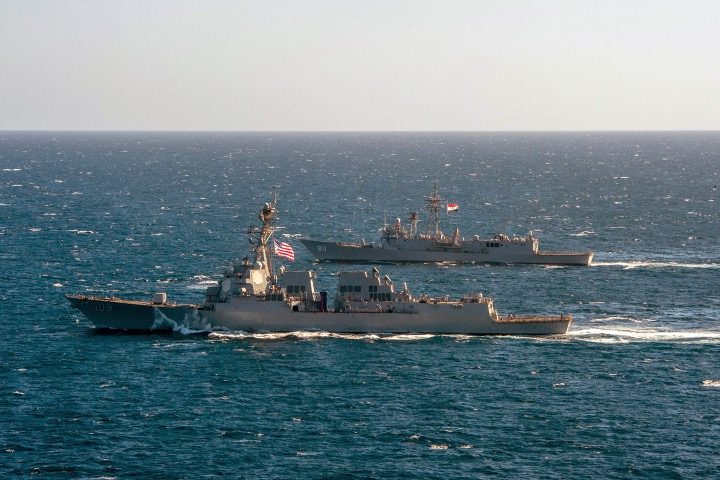
With U.S. maritime interests in the Red Sea continuing to be threatened, America is finding itself forced to respond militarily — heightening tensions with regional power Iran.
As reported by CNN, there was a major incident on Saturday in which a U.S. destroyer shot down a dozen drones sent by Yemen’s Houthi militia. American officials say the Houthis are going after commercial ships traveling toward Israel in the wake of the conflict in Gaza. On Monday, Secretary of Defense Lloyd Austin announced a new operation aimed at protecting commercial vessels in the Red Sea and Gulf of Aden.
Experts who spoke to the outlet said the American destroyer tasked with protecting these ships is armed with “surface-to-air missiles, explosive shells from the destroyer’s 5-inch main gun and close-in weapons systems.”
The hostilities from the Houthi militia, which is supported by Iran, have been ongoing since October 7 Hamas attack on Israel. The group classifies any ship en route to Israel as a “legitimate threat” — part of its effort to pressure Israel into ceasing its offensive in Gaza. Common tactics by the Houthi include drone strikes and missile attacks, and there was even one attempt to hijack a vessel by trying to land a helicopter on it.
Speaking to CNN, former CIA chief David Petreus called the region “one of the most important arteries in the world when it comes to maritime shipping,” adding that the conflict “will have a real impact on the global economy.”
Already, the biggest shipping firms in the world have temporarily halted transit through one artery, which analysts say could tangle up supply chains and raise freight costs. Companies MSC, Maersk, CMA CGM, Hapag-Lloyd, and BP have all announced that they are avoiding the Suez Canal due to safety concerns. The latter’s announcement triggered a surge in oil and gas prices on Monday.
While the U.S. destroyer’s Phalanx close-in weapons system has thus far been sufficient to protect merchant vessels, experts say resources may soon be depleted if the Houthi increase their hostilities.
Per CNN:
And the Phalanx system can’t protect merchant ships the US destroyer may be watching over, sailing miles away from the warship.
… US anti-aircraft interceptor missiles on US warships are fired from vertical launch system (VLS) cells on the deck.
Each cell can contain a mix of armaments (exact numbers are classified), but the number aboard any one vessel is finite….
And if the Houthis can deplete a ship’s inventories with successive attacks, the warship could find itself short on munitions to protect the merchant vessels it’s watching over, said Salvatore Mercogliano, a naval expert and professor at Campbell University in North Carolina.
The concern among officials is that U.S. forces will be unable to keep pace with the Houthi aggression in order to successfully protect the commercial ships. One type of attack that could overwhelm American naval vessels is a drone swarm attack, which is similar to what Russia has repeatedly carried out in Ukraine.
The U.S. is attempting to get other nations on board its effort to defend the Middle Eastern waters from the Houthi militants. On Tuesday, Austin spoke at a virtual meeting on maritime security attended by 42 other countries. The American defense secretary called the Houthi attacks “a serious international problem” that demands “a firm international response.”
“These attacks threaten the free flow of commerce and endanger innocent mariners. They must stop,” Austin added.
As part of U.S. efforts to secure the region, Austin this week announced Operation Prosperity Guardian in the Red Sea. The operation includes the participation of Bahrain, Canada, France, Italy, Netherlands, Norway, Seychelles, Spain, and the United Kingdom.
The Houthi movement, officially known as Ansar Allah, is a Shia Islamist political and military organization that emerged from the Saada Governorate of Yemen in the 1990s and has the backing of Iran. Tehran has utilized militia like the Houthi to gain power in neighboring countries for decades. In the 1980s it helped finance and arm Lebanese Hezbollah, and it has given support to the regime of Bashar al-Assad in Syria.
The strategy has yielded significant fruits for Tehran. In Iraq’s 2021 elections, Iran-linked political parties, most of whom have their own militia wings, for the first time won enough seats in Parliament to form a governing coalition, selecting Mohammed Shia al-Sudani as prime minister. Thus, the destinies of Iran and Iraq are now intimately connected. Hoshyar Zebari, who was Iraq’s foreign minister for 10 years and finance minister until 2016, went so far as to tell The New York Times that Iran is “the predominant influence in Iraq today.”
The political situation explains the subdued, defensive posture currently assumed by Washington with regard to the Houthi militia. Policymakers are faced with the reality that the hostilities could easily precipitate into an outright conflict with Iran, which, in turn, is closely supported by China and Russia.




